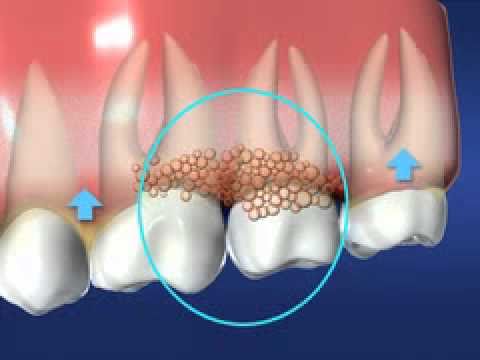Gum disease treatment
What causes gum disease?
Our mouths are full of bacteria. These bacteria, along with mucus and other particles, constantly form a sticky, colorless “ plaque” on teeth. Brushing and flossing help get rid of plague. Plaque that are not removed can harden and form “tartar” that brushing doesn’t clean. Only a professional cleaning by a dentist or dental hygienist can remove tartar.
Gingivitis
The longer plaque and tartar are on teeth, the more harmful they become. The bacteria cause inflammation of the gums that is called “gingivitis.” In gingivitis, the gums become red, swollen and can bleed easily. Gingivitis is a mild form of gum disease that can usually be reversed with daily brushing and flossing, and regular cleaning by a dentist or dental hygienist. This form of gum disease does not include any loss of bone and tissue that hold teeth in place.
Periodontitis
When gingivitis is not treated, it can advance to “periodontitis” (which means “inflammation around the tooth. ”In periodontitis, gums pull away from the teeth and form spaces (called “pockets”) that become infected. The body’s immune system fights the bacterial as the plaque spreads and grows below the gum line. Bacterial toxins and the body’s natural response to infection start to break down the bone and connective tissues that hold teeth in place. If not treated, the bones, gums, and tissue that support the teeth are destroyed. The teeth may eventually become loose and have to be removed.
Who gets gum disease?
People usually don’t show signs of gum disease until they are in their 30s – 40s. Men are more likely to have gum disease than women. Although teenagers rarely develop periodontitis, the milder form of gum disease. Most commonly, gum disease develops when plaque is allowed to build up along and under the gum line.
How do I know if I have gum disease?
Symptoms of gum disease are as follows:
- Bad breath that won’t go away
- Red or swollen gums
- Tender or bleeding gums
- Painful chewing
- Loose teeth
- Sensitive teeth
- Receding gums or longer appearing teeth
Any of these symptons may be a serious problem, which should be checked by a dentist. At your dental visit the dentist or hygienist should:
- Ask about your medical history to identify underlying conditions or risk factor (such as smoking) that may contribute to gum disease.
- Examine your gums and note any signs of inflammation.
- Use a tiny ruler called a ‘probe’ to check for and measure any pockets. In a healthy mouth, the depth of these pockets is usually between 1 and 3 millimeters. This test for pocket depth is usually painless.

The dentist or hygienist may also:
- Take an x-ray to see whether there is any bone loss.
- Refer you to a periodontist. Periodontist are experts in diagnosis and treatment of gum disease and may provide you with treatment options that are not offered by your dentist.
How is gum disease treated?
The main goal of treatment is to control the infection. The number and types of treatment may vary, depending on the extent of the gum disease. Any type of treatment requires that the patient keep up good daily care at home. The doctor may also suggest changing certain behaviors, such as quit smoking, is a way to improve treatment outcome.
Treatments range from non-surgical therapies that control bacterial growth to surgery to restore supportive tissues.
Non-surgical Treatments for Gum Disease
Treatments for gum disease that don’t involve surgery includes:
- Professional dental cleaning: During a typical checkup your dentist or dental hygienist will remove the plaque and tartar (plaque that builds up and hardens on the tooth surface and can only be removed with professional cleaning) from above and below the gum line of all teeth. If you have some signs of gum disease, your dentist may recommend professional dental cleaning more than twice-a-year.

- Scaling and root planing: This is a deep-cleaning, non-surgical procedure, done under a local anaesthetia, whereby plaque and tartar from above and below the gum line are scraped away (scaling) and rough spots on the tooth root are made smooth (planing). Smoothing the rough spots removes bacteria and provides a clean surface for the gums to re-attach to the teeth. Scaling and root planing is done if your dentist or periodontist determines that you have plaque and calculus (hardened plaque, also called tartar) under the gums that needs to be removed.
Surgical Treatments for Gum Disease
Some treatments for gum disease are surgical. Some examples are:
- Flap surgery/pocket reduction surgery. During this procedure the gums are lifted back and the tartar is removed. In some cases, irregular surfaces of the damaged bone are smoothed to limit areas where disease-causing bacteria can hide. The gums are then placed so that the tissue fits snugly around the tooth. This method reduces the size of the space between the gum and tooth, thereby decreasing the areas where harmful bacteria can grow and decreasing the chance of serious health problems associated with periodontal disease.
- Bone graft. This procedure involves using fragments of your own bone, synthetic bone, or donated bone to replace bone destroyed by gum disease. The grafts serve as a platform for the re-growth of bone, which restores stability of teeth. New technology, called tissue engineering, encourages your own body to regenerate bone and tissue at an accelerated rate.
- Soft tissue grafts. This procedure reinforces thin gums or fills in places where gums have receded. Grafted tissue, most often taken from the roof of the mouth, is stitched in place, adding tissue to the affected area.
Medications.
Medications may be used with treatment that includes scaling and root planning, but they cannot always take the place of surgery. Depending on how far the disease has progressed, the dentist or periodontist may still suggest surgical treatment. Long – term need for surgery and whether they are effective over a long period of time. Listed on the next page are some medications that are currently used.

 Tiếng Việt
Tiếng Việt